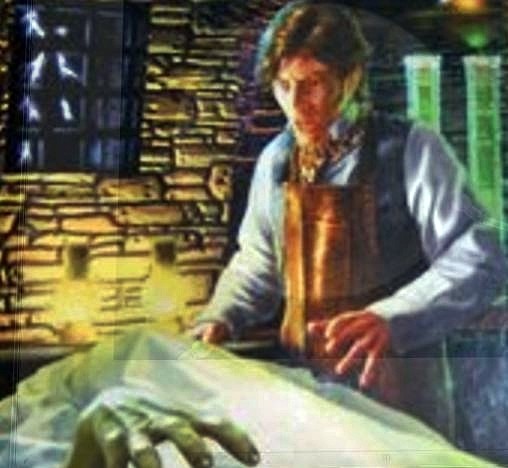Victor von Frankenstein Saved Humankind from Becoming Extinct at the Hands of his Monster
| Arthur Dominic Villasanta | | Oct 30, 2016 07:07 PM EDT |
Victor von Frankenstein and his Creature.
Dr. Victor von Frankenstein, long pilloried as the "mad scientist" who created "Frankenstein's monster" (or Frankenstein to Hollywood), also opened a searing scientific debate over the results of competition among two near-peer dominant species now called the "principle of competitive exclusion."
Like Us on Facebook
In her 1818 novel, "Frankenstein," author Mary Shelly explored the destructive consequences of scientific and moral transgressions. A new study published in the peer-reviewed scientific journal BioScience argues that the horror of Shelley's gothic novel is rooted in a fundamental principle of biology.
The study by Dartmouth College researchers points to a pivotal scene in the novel when the Creature encounters Victor Frankenstein and requests a female companion to mitigate his loneliness.
The Creature distinguishes his dietary needs from those of humans and expresses a willingness to inhabit the "wilds of South America," suggesting distinct ecological requirements.
Frankenstein concedes to this reasoning given that humans would have few competitive interactions with a pair of isolated creatures in South America. He then reverses his decision after considering the creatures' reproductive potential and the probability of human extinction, a concept we now call "competitive exclusion."
In essence, Frankenstein the scientist saved humankind.
"The principle of competitive exclusion was not formally defined until the 1930s," said Nathaniel J. Dominy, a professor of anthropology and biological sciences at Dartmouth.
"Given Shelley's early command of this foundational concept, we used computational tools developed by ecologists to explore if, and how quickly, an expanding population of creatures would drive humans to extinction."
The authors developed a mathematical model based on human population densities in 1816, finding that the competitive advantages of creatures varied under different circumstances.
The worst-case scenario for humans was a growing population of creatures in South America, as it was a region with fewer humans and therefore less competition for resources.
"We calculated that a founding population of two creatures could drive us to extinction in as little as 4,000 years," said Dominy.
Although the study is merely a thought experiment, it casts new light on the underlying horror of the novel: our own extinction. It also has real word implications for how we understand the biology of invasive species.
"To date, most scholars have focused on Mary Shelley's knowledge of then-prevailing views on alchemy, physiology and resurrection; however, the genius of Mary Shelley lies in how she combined and repackaged existing scientific debates to invent the genre of science fiction," said Justin D. Yeakel, an Omidyar fellow at the Santa Fe Institute and an assistant professor in the School of Natural Sciences at the University of California, Merced.
"Our study adds to Mary Shelley's legacy, by showing that her science fiction accurately anticipated fundamental concepts in ecology and evolution by many decades."
TagsDr. Victor von Frankenstein, Frankenstein's monster, Frankenstein, Mary Shelly, Dartmouth College, competitive exclusion
©2015 Chinatopix All rights reserved. Do not reproduce without permission
 London Conference to Titillate with Talks about Robot Sex and ‘Sexbots’
London Conference to Titillate with Talks about Robot Sex and ‘Sexbots’ Study Examines how Artificial Intelligence Might Affect Urban Life in 2030
Study Examines how Artificial Intelligence Might Affect Urban Life in 2030 Harvard Researchers Create ‘Octobot,’ the First Autonomous, Entirely Soft Robot
Harvard Researchers Create ‘Octobot,’ the First Autonomous, Entirely Soft Robot DARPA Wants to Understand how AI Systems Reach Decisions
DARPA Wants to Understand how AI Systems Reach Decisions Google and FHI Create Red Button Kill Switch to Deactivate Bad AI Robots
Google and FHI Create Red Button Kill Switch to Deactivate Bad AI Robots
EDITOR'S PICKS
-

Did the Trump administration just announce plans for a trade war with ‘hostile’ China and Russia?
-

US Senate passes Taiwan travel bill slammed by China
-

As Yan Sihong’s family grieves, here are other Chinese students who went missing abroad. Some have never been found
-

Beijing blasts Western critics who ‘smear China’ with the term sharp power
-

China Envoy Seeks to Defuse Tensions With U.S. as a Trade War Brews
-

Singapore's Deputy PM Provides Bitcoin Vote of Confidence Amid China's Blanket Bans
-

China warns investors over risks in overseas virtual currency trading
-

Chinese government most trustworthy: survey
-

Kashima Antlers On Course For Back-To-Back Titles
MOST POPULAR
LATEST NEWS
Zhou Yongkang: China's Former Security Chief Sentenced to Life in Prison

China's former Chief of the Ministry of Public Security, Zhou Yongkang, has been given a life sentence after he was found guilty of abusing his office, bribery and deliberately ... Full Article
TRENDING STORY

China Pork Prices Expected to Stabilize As The Supplies Recover

Elephone P9000 Smartphone is now on Sale on Amazon India

There's a Big Chance Cliffhangers Won't Still Be Resolved When Grey's Anatomy Season 13 Returns

Supreme Court Ruled on Samsung vs Apple Dispute for Patent Infringement

Microsoft Surface Pro 5 Rumors and Release Date: What is the Latest?










